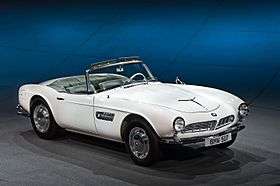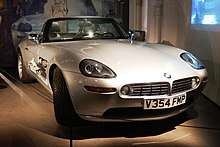BMW Z8
| BMW Z8 | |
|---|---|
_(cropped).jpg) | |
| Overview | |
| Manufacturer | BMW |
| Production |
March 2000–2003 (5,703 produced) |
| Assembly | Munich, Germany |
| Designer |
Henrik Fisker (exterior: 1995) Scott Lempert (interior: 1995)[1] Chris Bangle (design manager) Wolfgang Reitzle (R&D director) |
| Body and chassis | |
| Class | Sports car (S) |
| Body style | 2-door Roadster |
| Layout | FMR layout |
| Related | BMW M5 (E39) |
| Powertrain | |
| Engine |
4.9 L S62 V8 4.8 L M62 V8 (Alpina V8 Roadster) |
| Transmission |
6-speed manual 5-speed automatic (Alpina V8 Roadster) |
| Dimensions | |
| Wheelbase | 98.6 in (2,500 mm) |
| Length | 173.2 in (4,400 mm) |
| Width | 72 in (1,800 mm) |
| Height | 51.9 in (1,320 mm) |
| Curb weight | 3,494 lb (1,585 kg)[2] |
| Chronology | |
| Predecessor | BMW 507 |
The BMW Z8 is a roadster produced by German automotive manufacturer BMW from 2000 to 2003. It was given the E52 BMW model code.
The Z8 was developed under the codename "E52" between 1993 and 1999, through the efforts of a design team led by Chris Bangle from 1993 to 1995.[3] The exterior was designed by Henrik Fisker and the interior by Scott Lempert up until 1995, when the latter left BMW and styling was approved.[4] The Z8 originally was designed as a styling exercise intended to evoke and celebrate the 1956-'59 BMW 507. Prototypes were spotted in testing between 1996 and 1999.[5] A concept was later developed to preview the Z8, called the Z07 and was showcased in October 1997 at the 1997 Tokyo Auto Show.
Z07 Concept
The Z07 Concept had been based on the concurrently running E52 development programme. As a result, practical and regulatory considerations necessitated very few changes for the production model. Comparatively, the windshield of the series production Z8 was more upward, and had a larger front airdam. The Z8 hardtop differed from the Z07 in being a double-bubble form with a tapering faring versus a single dome with a truncated convex backside.[6] The Z07's exotic driver's side helmet fairing was never intended for production, in order to allow easy operation of the power soft top.

The side-mounted turn indicators were integrated into the side vents in a fashion that rendered them invisible until activated. The vintage simplicity of the interior was preserved by hiding the modern equipment under retracting panels. Complex compound curves were made through the use of an expensive MIG-welded aluminum space frame.
Specifications and features
.jpg)
.jpg)
The Z8 cost US$128,000, had an all-aluminum chassis and body, and used a 4,941 cc (4.9 L; 301.5 cu in) DOHC 4 valves per cylinder V8 engine, with a bore X stroke of 94 mm × 89 mm (3.7 in × 3.5 in), developing 400 PS (395 bhp; 294 kW) at 6,600 rpm and 500 N⋅m (369 lbf⋅ft) of torque at 3,800 rpm.[7] This engine, known internally as the S62, was built by the BMW Motorsport subsidiary and was shared with the E39 M5 sports saloon. The engine was located behind the front axle in order to provide the car with 50/50 weight distribution. The factory claimed a 0–100 km/h (0–62 mph) acceleration time of 4.7 seconds; Motor Trend magazine achieved 0–96 km/h (0–60 mph) in 4.2 seconds. Road and Track measured the car's lateral grip at .92. Car and Driver magazine also tested the car and found that it outperformed the contemporary benchmark Ferrari 360 Modena in three important performance categories: acceleration, handling, and braking. As with most BMW cars, its top speed was electronically limited to 250 km/h (155.4 mph) with the delimited top speed amounting to an estimated 290 km/h (180 mph).
The Z8 used neon exterior lighting, the tail lights and turn indicators are powered by neon tubes that offer quicker activation than standard lightbulbs and are expected to last for the life of the vehicle.
Every Z8 was shipped with a colour-matching metal hardtop with rear defroster. Unlike many contemporary hardtops, which are provided for practical rather than stylistic considerations, the Z8 hardtop was designed from the outset to complement the lines of the roadster.
In order to keep the interior uncluttered, a number of functions were integrated into multifunction controls. For example, the power windows and mirrors were controlled by a single instrument. Also, the centre-mounted instrument cluster was canted slightly toward the driver. The displacement of these gauges to the middle of the dash board was intended to offer an unimpeded view of the hood and the road ahead.
In order to promote the Z8 to collectors and reinforce media speculation about the Z8's "instant classic" potential, BMW promised that a 50-year stockpile of spare parts would be maintained in order to support the Z8 fleet. Due to the limited volume of Z8 production, all elements of the car were constructed or finished by hand, thereby compounding the importance of ongoing manufacturer support for the type. The price point and production process allowed BMW to offer custom options to interested buyers. A significant number of Z8s with bespoke paint and interior treatments were produced over the course of the four-year production run by BMW Individual, a division of BMW AG.
Z8 Safety Car
A safety car variant of the Z8 was produced[8] for use in the 2001 season of the MotoGP.[9]
Alpina V8 Roadster
.jpg)
With production of the Z8 completed by November 2002, the Z8 was replaced by the Alpina V8 Roadster in 2003.[10] The Alpina was a departure from the hard-edged sporting focus of the original car, and elements of grand touring intent were evident throughout this final iteration. Instead of the original 6-speed manual and 4.9 L (S62) engine featured in original Z8, the Alpina came only with an automatic transmission, utilising a 5-speed BMW Steptronic transmission mated to a 4.8 L Alpina-tuned BMW M62 V8 engine from the Alpina E39 B10 V8 S. In order to complete the car's transition from a sports car to a refined grand tourer, a softer suspension setting was used. The standard Z8's run-flat tyres on 18 in (46 cm) wheels were discarded in favor of conventional tyres with softer sidewalls mounted on 20 in (51 cm) Alpina wheels.[11] A new softer grade of Nappa leather replaced the Z8's less supple specification, and special Alpina gauges were featured on the dash board cluster. An Alpina steering wheel with three solid spokes replaced the original, which could not be retrofitted with shift paddles for the automatic transmission. Gear selection was displayed in an Alpina-specific display mounted in front of the wheel.
Performance of the Alpina V8 differed from that of the standard car in that the peak power was reduced to 375 hp (280 kW), while peak torque was raised to 383 lb⋅ft (519 N⋅m); this torque was available at significantly lower rpm than the original in order to enable more relaxed cruising.[12] Curiously, the electronically limited top speed was officially raised to 161 mph (259 km/h).[10]
Only 555 of the Alpina V8 roadsters were built, 450 of which were exported to the U.S. market and only eight to the UK.[13] In the United States, this special edition of the Z8 was sold directly through BMW dealerships, marking a first for Alpina, whose cars had never been sold through retail channels in the U.S.
Production
The Z8's spaceframe was produced in the Dingolfing Plant[14] and the car was hand-finished in Munich.[15] 5,703 Z8s were built in total, 3,160 in for the world market and 2,543 for the US market.[16]
In popular culture

The Z8 was showcased as James Bond's car in the film The World is Not Enough released in November 1999, from scenes shot in early April 1999.[17][18]
U.S. sales
| Calendar year | U.S sales |
|---|---|
| 2000[19] | 317 |
| 2001[20] | 970 |
| 2002 | 524 |
| 2003[21] | 439 |
| 2004[21] | 110 |
| 2005 | 17 |
| 2006 | 5 |
Notes
- ↑ https://de.linkedin.com/in/scottlempert/de%5Bpermanent+dead+link%5D
- ↑ "Car and Driver Aston Martin DB7 vs. BMW Z8, Ferrari 360 Spider Comparison Test" (PDF).
- ↑ "Z8 History". Bmwz8.us. Retrieved 2018-08-25.
- ↑ The BMW Z8 birth book/coffee table book which was issued to every BMW Z8 owner
- ↑ http://www.bmwz8.us/pdf/1996_06_car.pdf
- ↑ "BMW Z07 Concept". BMW BLOG. 2015-05-20. Retrieved 2018-08-13.
- ↑ "1999 BMW Z8 E52 E52". carfolio.com. February 28, 2013. Retrieved June 18, 2018.
- ↑ "Z8 History". bmwz8.us. Retrieved 31 August 2017.
- ↑ "BMW M MotoGP". bmw-m.com. Retrieved 31 August 2017.
- 1 2 Hutton, Ray. "BMW Alpina Roadster V-8". Car and Driver. Retrieved 16 March 2012.
- ↑ "Let's all stare at this gorgeous Z8 Alpina Roadster". Top Gear. 2018-05-23. Retrieved 2018-08-13.
- ↑ "Alpina Z8 Roadster Is Asking for $244,900 to Come Home with You". BMW BLOG. 2017-08-28. Retrieved 2018-08-13.
- ↑ Buckley, Martin. "BMW Aplina Roadster V8". Evo. Retrieved 16 March 2012.
- ↑ "Produktion Z8". BMW. Archived from the original on 8 July 2003. Retrieved 29 December 2017.
- ↑ "BMW Group Plant Munich History". www.bmwgroup-plants.com. Retrieved 29 December 2017.
- ↑ BMW Z8 Club e.V.
- ↑ "Annual Report 2000" (PDF). BMW. Archived from the original (PDF) on 20 June 2013. Retrieved 16 March 2012.
- ↑ "7.3 007-The World Is Not Enough". Azer.com. 1942-09-25. Retrieved 2018-08-25.
- ↑ "2001 BMW Z8 Reviews by Cars.com Experts and Consumers". Cars.com. Retrieved 2009-07-25.
- ↑ "2002 BMW Z8 Summary". Cars.com. Retrieved 2009-07-25.
- 1 2 "BMW Group Shatters All Past Annual Sales Records in 2004". Theautochannel.com. 2004-11-17. Retrieved 2009-07-25.
References
- Csere, Csaba. "BMW Z8 Preview". Car and Driver (May 2000): 66&ndash, 70.
- Holmes, Mark (2007). Ultimate Convertibles: Roofless Beauty. London: Kandour. pp. 38–39. ISBN 978-1-905741-62-5.
External links
| Wikimedia Commons has media related to BMW Z8 (E52). |
- Frame Damage The BusinessWeek article about frame deformation
« previous — BMW cars: 1980s to 2000s — next » | |||||||||||||||||||||||||||||||||||
|---|---|---|---|---|---|---|---|---|---|---|---|---|---|---|---|---|---|---|---|---|---|---|---|---|---|---|---|---|---|---|---|---|---|---|---|
| Series | 1980s | 1990s | 2000s | ||||||||||||||||||||||||||||||||
| 0 | 1 | 2 | 3 | 4 | 5 | 6 | 7 | 8 | 9 | 0 | 1 | 2 | 3 | 4 | 5 | 6 | 7 | 8 | 9 | 0 | 1 | 2 | 3 | 4 | 5 | 6 | 7 | 8 | 9 | ||||||
| 1 Series | E87>> | ||||||||||||||||||||||||||||||||||
| 3 Series | <<E21 | E30 | E36 | E46 | E90>> | ||||||||||||||||||||||||||||||
| 5 Series | <<E12 | E28 | E34 | E39 | E60>> | ||||||||||||||||||||||||||||||
| 6 Series | <<E24 | E63>> | |||||||||||||||||||||||||||||||||
| 7 Series | <<E23 | E32 | E38 | E65 | F01>> | ||||||||||||||||||||||||||||||
| 8 Series | E31 | ||||||||||||||||||||||||||||||||||
| Z Series | Z1 | Z3 | Z4 (E85) | Z4 (E89>> | |||||||||||||||||||||||||||||||
| Z8 | |||||||||||||||||||||||||||||||||||